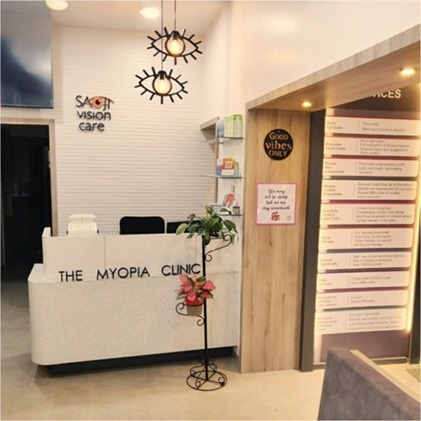
Strengthen that weak cornea, avoid vision loss
(Collagen cross-linking procedure, C3-R@)
What is the collagen cross-linking procedure?
Collagen cross-linking (C3R or CXL) procedure is performed to improve the stiffness of the cornea, which is the transparent layer in front of the eye in certain conditions. The process strengthens the tissue of the cornea by inducing “cross-links” between the internal tissues of a layer of the cornea(stroma), thus reinforcing the structure.
This FDA-approved technique is most commonly used as a treatment in conditions called “ectasias” like keratoconus, corneal swelling, pellucid marginal degeneration, terriens marginal degeneration, and postrefractive surgery (such as LASIK, PRK, or radial keratotomy) ectasia. The condition’s progression is decided on several parameters like your refractive power, vision, the shape of the cornea, etc.
The procedure cannot reverse the condition but can help to stop any further progression. It does not require multiple sittings and has a quick recovery time. There is no need for stitches or incisions, and it is a single-day outpatient procedure.
What is ectasia?
The word ‘ectasia’ means elongation or distention of a tubular structure. In the eye, when the cornea elongates unnaturally, then it is referred to as corneal ectasia.
The most commonly seen ectasia in the clinic is keratoconus. In keratoconus, the cornea elongates and thins out unevenly across the cornea. This thinning out gives the eye a conical shape and appearance and makes the cornea weaker. This condition is commonly seen in young adults (aged 10-25) and is progressive.
The cause behind this condition is still unclear, but it is often due to genetics, allergies, excessive rubbing of eyes or the presence of some other diseases like Marfan’s syndrome, Down’s syndrome, etc.
The uneven bulging of the eye causes distortions in vision, blurred vision, double vision (monocular diplopia) and high sensitivity to light. The early stages of the condition are treated with spectacles and contact lenses.As the disease progresses, it requires advanced treatment like a corneal transplant.
As the disease keeps progressing, it could potentially lead to corneal scarring, which could hamper your vision., Therefore, controlling the progression is crucial. Currently, across the globe, the progression of the disease is controlled through procedures like the collagen cross-linking procedure.
Figure 1: Normal cornea versus cornea with keratoconus
Source: https://www.dreamstime.com/stock-photo-keratoconus-image28287620 — (Sample version used)
Collagen cross-linking will be deferred if any of the following conditions exist:
• Low corneal thickness — The thickness of the cornea is crucial for the success of this procedure. The average corneal thickness ranges from 520 to 540 microns. In most practices, a minimum corneal thickness of 400 microns for the procedure is considered mandatory for C3R.
• Prior history of Herpetic infection — C3R has been reported to cause complications if there is a history of any herpes-related infection.
• Presence of any concurrent ocular infection
• Severe scarring or opacification of the cornea
• Neurotrophic keratopathy
• Past history of poor wound healing of the cornea
• Severe dry eye
• Autoimmune conditions
• Pregnancy
What happens during the procedure?
The procedure is minimally invasive, which involves the use of eye drops and Ultra-violet (UV-A light,
365nm) light. First, Riboflavin (Vitamin B2) eye drops will be put in your eyes. Riboflavin eye drops help increase the treatment’s effectiveness by increasing the absorption of UV light in the cornea. It also helps to protect the internal tissues of the eye from UV light. The drops are then allowed to soak into the eyes for about 30 minutes.
After applying the drops, your eyes will be safely exposed to UV light for few minutes. The exposure is minimal, and the dose of UV is equivalent to 15-20 minutes of sun exposure on a summer day. The entire procedure takes about 60 to 90 minutes, depending on the variant of the procedure performed.
Once the procedure is complete, you may be prescribed antibiotic eye drops and a bandage contact lens to protect your eyes. Protective eyewear(sunglasses) may be prescribed to protect your eyes for the initial few days after the procedure.
There are two commonly practised methods of this procedure (i.e.) Epithelium “on” and Epithelium “off” procedure. The epithelium is the outermost layer of the cornea.
1. Epithelium “off” (Epi-off) technique — The surgeon will remove the epithelium before the drops are applied. Removing this allows the drops to flow deep into the cornea. This is the standard technique because of its good results.
2. Epithelium “on” technique— This technique requires no significant additional procedure except drops and UV exposure.
Your surgeon may modify specific procedures based on your eye measurements (such as the thickness of the cornea).
Figure 2: Illustration of the cornea before and after collagen cross-linking procedure
Complications of Collagen cross-linking procedure
• Although C3R is a reasonably simple procedure; some patients may develop the following complications:
• Eye infections
• Ulcers in the cornea
• Temporary corneal haze (cloudy cornea)
• Permanent scars on the cornea
• Damage to the innermost and sensitive layer of the cornea(the endothelium)
• Treatment failure
• Reactivation of herpes infection
What to expect after the collagen cross-linking procedure?
Three months after the procedure, stable refractive error and no further progression in the condition would be expected if there are no complications after the procedure.
Advice Points to remember after C3R treatment
Apply drops regularly — After the procedure, you will be prescribed antibiotic eye drops and lubricating eye drops to be applied regularly, as advised by the ophthalmologist. Your eyes are expected to have some dryness and irritation after the procedure for a few weeks. The lubricating drops would help to reduce discomfort and itching.
Do not rub your eyes
Avoid rubbing your eyes immediately after the procedure. The ophthalmologist would have fitted a bandage contact lens inside, and rubbing it would lead it to come out. By chance, if the bandage contact lens comes out of the eye, do not try to put it back in the eye. In this situation, it is best to contact your ophthalmologist immediately.
Vision is expected to be blurry for a few days. After C3R, the vision might be blurry and may fluctuate for a few days. Do not worry in such conditions as this results from the removal of the epithelium, which makes the surface of the eye rough. The epithelium layer of the cornea will regenerate within seven to ten days.
After which, the surface gets smoother, causing the vision to recover.
Avoid eye makeup and dusty environments
Avoid using extensive eye makeup immediately after your procedure as particles may irritate your eyes. Besides, the removal of makeup could cause you to touch the healing cornea; hence it is best avoided. Dusty environments must be avoided to prevent any chance of exposing your eyes to any unwanted particles.
Wear sunglasses
After C3R, your eyes may be more sensitive to bright lights for the initial days after the surgery. It is advised to wear sunglasses for comfort and to protect your eyes during outdoor activities. Good eye hygiene should be maintained at all times.
Spectacle power might vary during the first few months after C3R
Your spectacle prescription is likely to change for the first six months after your C3R procedure. Most patients develop a stable power within three months, but some might take up to one year to stabilize. Rest assured, this does not mean that the procedure has not worked well or has failed.
Conclusion:
Collagen cross-linking is a minimally invasive procedure with a reasonable success rate. The effects of the procedure are permanent and can help prevent any further progression of conditions like keratoconus. With good surgery after-care, this treatment can be safe and effective.
